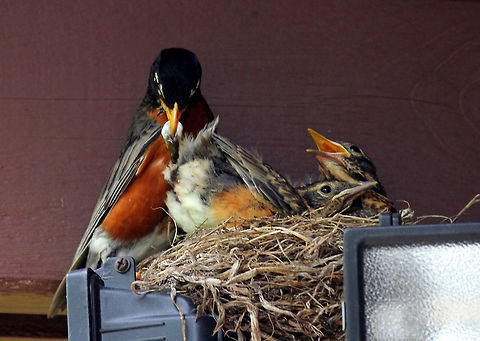
Appearance
The nominate subspecies of the American Robin is 23 to 28 cm long with a wingspan ranging from 31 to 41 cm, with similar size ranges across all races.The species averages about 77 g in weight, with males ranging from 72 to 94 g and females ranging from 59 to 91 g. Among standard measurements, the wing chord is 11.5 to 14.5 cm, the culmen is 1.8 to 2.2 cm and the tarsus is 2.9 to 3.3 cm.
The head varies from jet black to gray, with white eye arcs and white supercilia. The throat is white with black streaks, and the belly and undertail coverts are white. The Robin has a brown back and a reddish-orange breast, varying from a rich red maroon to peachy orange. The bill is mainly yellow with a variably dark tip, the dusky area becoming more extensive in winter, and the legs and feet are brown.
The sexes are similar, but the female tends to be duller than the male, with a brown tint to the head, brown upperparts and less bright underparts. However, some birds cannot be safely sexed on plumage alone. The juvenile is paler in color than the adult male and has dark spots on its breast, and whitish wing coverts. First-year birds are not easily distinguishable from adults, but they tend to be duller, and a small percentage retains a few juvenile wing coverts or other feathers.
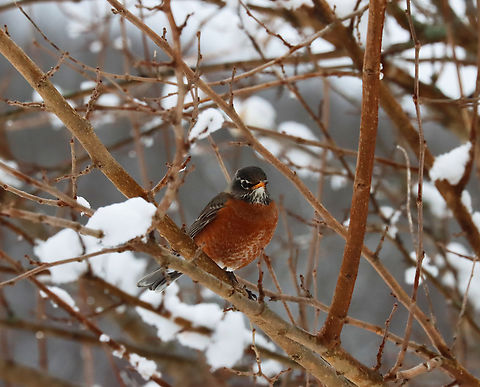
Distribution
This bird breeds throughout most of North America, from Alaska and Canada southward to northern Florida and Mexico. While Robins occasionally overwinter in the northern part of the United States and southern Canada, most migrate to winter south of Canada from Florida and the Gulf Coast to central Mexico, as well as along the Pacific Coast. Most depart south by the end of August and begin to return north in February and March.This species has also occurred as a vagrant to Greenland, Jamaica, Hispaniola, Puerto Rico and Belize. Vagrants to Europe, where identified to subspecies, are nominate "T. m. migratorius", but the Greenland birds also included "T. m. nigrideus", and some of the southern overshots may have been "T. m. achrusterus".
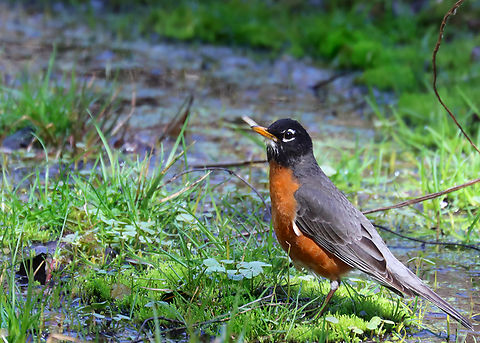
Status
The American Robin has an extensive range, estimated at 16 million square kilometers, and a large population of about 320 million individuals. The species is not believed to approach the thresholds for the population decline criterion of the IUCN Red List, and is therefore evaluated as Least Concern. At one point, the bird was killed for its meat, but it is now protected throughout its range in the United States by the Migratory Bird Act.Birds in central California of the subspecies "propinquus" are considered to be still increasing their range, and this is probably the case elsewhere in the U.S.A.
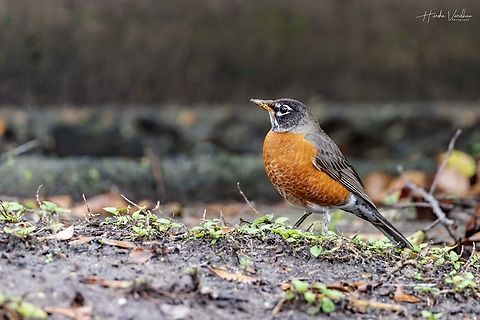
Behavior
The American Robin is active mostly during the day, and on its winter grounds it assembles in large flocks at night to roost in trees in secluded swamps or dense vegetation. The flocks break up during the day when the birds feed on fruits and berries in smaller groups. During the summer, the American Robin defends a breeding territory and is less social.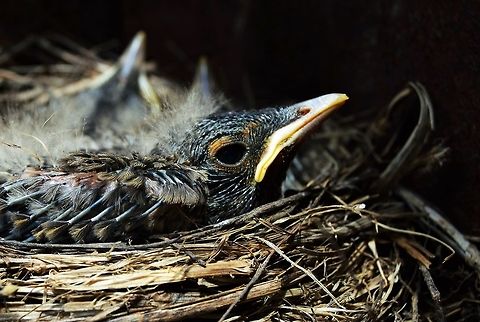
Habitat
The American Robin's breeding habitat is woodland and more open farmland and urban areas. It breeds only rarely in the Deep South of the United States and there prefers large shade trees on lawns. Its winter habitat is similar but includes more open areas.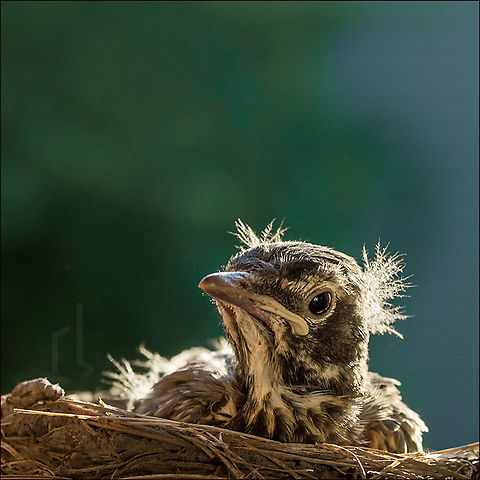
Reproduction
The American Robin begins to breed shortly after returning to its summer range. It is one of the first North American bird species to lay eggs, and normally has two to three broods per breeding season, which lasts from April to July.The nest is most commonly located 1.5–4.5 meters above the ground in a dense bush or in a fork between two tree branches, and is built by the female alone. The outer foundation consists of long coarse grass, twigs, paper, and feathers. This is lined with smeared mud and cushioned with fine grass or other soft materials. A new nest is built for each brood, and in northern areas the first clutch is usually placed in an evergreen tree or shrub while later broods are placed in deciduous trees. The American Robin does not shy away from nesting close to human habitation.
A clutch consists of three to five light blue eggs, and is incubated by the female alone. The eggs hatch after 14 days, and the chicks leave the nest a further two weeks later. The altricial chicks are naked and have their eyes closed for the first few days after hatching. While the chicks are still young, the mother broods them continuously. When they are older, the mother will brood them only at night or during bad weather.
The chicks are fed worms, insects, and berries. Waste accumulation does not occur in the nest because adults collect and take it away. Chicks are fed, and then raise tails for elimination of waste, a solid white clump that is collected by a parent prior to flying off. All chicks in the brood leave the nest within two days of each other. Even after leaving the nest, the juveniles will follow their parents around and beg food from them. Juveniles become capable of sustained flight two weeks after fledging.
The adult male and female both are active in protecting and feeding the fledged chicks until they learn to forage on their own. The adult Robin gives alarm calls and dive-bombs predators, including domestic cats, dogs and humans that come near the young birds. The fledglings are able to fly short distances after leaving the nest. The wings of juvenile birds develop rapidly, and it only takes a couple of weeks for them to become proficient at flying. The cryptically colored young birds perch in bushes or trees for protection from predators.
Bird banders have found that only 25% of young Robins survive the first year. The longest known lifespan in the wild of an American Robin is 14 years; the average lifespan is about 2 years.
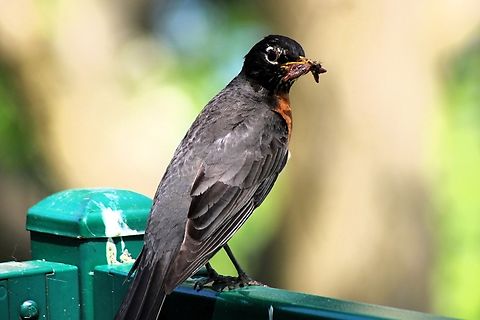
Food
The American Robin's diet generally consists of around 40 percent invertebrates, such as earthworms, beetle grubs, caterpillars and grasshoppers, and 60 percent wild and cultivated fruits and berries. They will flock to fermented Pyracantha berries, and in sufficient quantities will exhibit intoxicated behavior such as falling over while walking. It forages primarily on the ground for soft-bodied invertebrates, and finds worms by sight, pouncing on them and then pulling them up. Nestlings are fed mainly on worms and other soft-bodied animal prey. In some areas, Robins, particularly of the coastal race "T. m. caurinus" will feed on beaches, taking insects and small mollusks.The Robin uses auditory, visual, olfactory and possibly vibrotactile cues to find prey, but vision is the predominant mode of prey detection. It is frequently seen running across lawns, picking up earthworms and its "running and stopping" behavior is a distinguishing characteristic. It hunts visually, and it also has the ability to hunt by hearing. Experiments have discovered that it can find worms underground by simply using its listening skills. It typically will take several short hops and then cock its head left, right or forward as a means to detect movement of its prey. In urban areas, robins will gather in numbers soon after lawns are mowed or where sprinklers are in use.
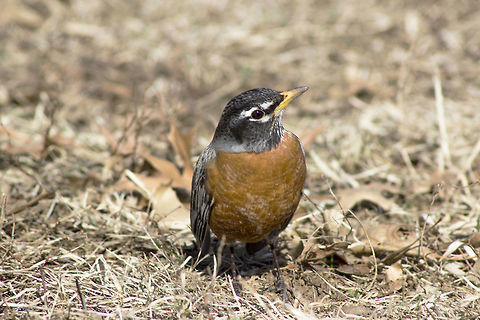
Predators
Juvenile Robins and eggs are preyed upon by squirrels, snakes, and some birds, such as Blue Jays, Common Grackles, American Crows and Common Ravens. Adults are primarily taken by hawks, cats and larger snakes, although when feeding in flocks, the American Robin is able to remain vigilant and watch other flock members for reactions to predators.The American Robin is known to be a rejecter of cowbird eggs, so brood parasitism by the Brown-headed Cowbird is rare. Even when it occurs, the parasite's chick does not normally survive to fledging. In a study of 105 juvenile Robins, 77.1% were infected with one or more species of endoparasite, with "Syngamus" species the most commonly encountered, found in 57.1% of the birds.
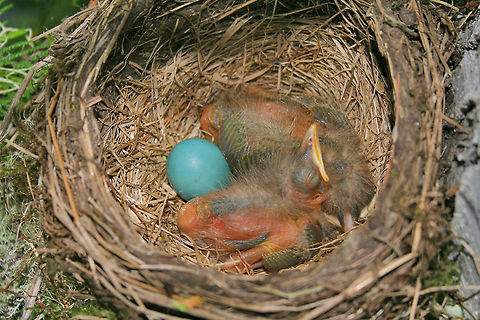
Cultural
The American Robin is the state bird of Connecticut, Michigan and Wisconsin. It was also depicted on the 1986 Birds of Canada series Canadian $2 note, but this note has since been withdrawn. "Robin's egg blue" is a color named after the bird's eggs.The American Robin has a place in Native American mythology. The story of how the robin got its red breast by fanning the dying flames of a campfire to save a Native American man and a boy is similar to those that surround the European Robin. The Tlingit people of Northwestern North America held it to be a culture-hero created by Raven to please the people with its song. One of the Houses of the Raven Tribe from the Nisga'a Nation holds the Robin as a House Crest.
The Peace Bridge robins were a family of American robins that attracted minor publicity in the mid-1930s for their prominent nest on the Canadian side of the Peace Bridge connecting Buffalo, New York to Fort Erie, Ontario.
The Robin is considered a symbol of spring. A well-known example is a poem by Emily Dickinson, "I Dreaded That First Robin So". Among other 19th-century poems about the first robin of spring is "The First Robin" by Dr. William H. Drummond, which according to the author's wife is based on a Quebec superstition that whoever sees the first robin of spring will have good luck.
American popular songs featuring this bird include "When the Red, Red Robin ", written by Harry M. Woods and a hit for Al Jolson and others, and "Rockin' Robin", written by Roger Thomas and a hit for Bobby Day and others.
Although the comic-book superhero Robin was inspired by an N. C. Wyeth illustration of Robin Hood, a later version had his mother nicknaming him Robin because he was born on the first day of spring. His red shirt suggests the bird's red breast.
References:
Some text fragments are auto parsed from Wikipedia.